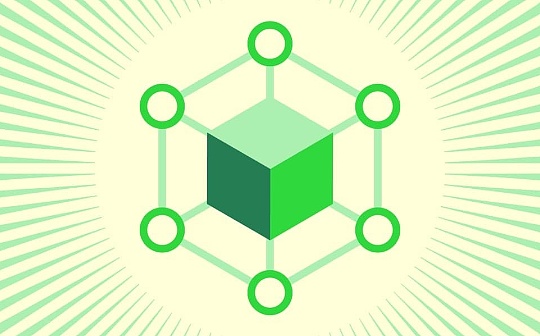
Source: ASXN, Digital Asset Research Company; Translation: Bitchain Vision Xiaozou
1. Foreword
The encryption industry is full of changes. One of the few constant matters is that the number of blockchain is growing.Whether it is Ethereum L2, the application chain, or Alt L1, it seems that there have always been a large number of new blockchain layers.
Although different blockchain provides users with many different choices, it also challenges developers and multi -chain users.More and more chains will cause fragmented problems with liquidity and use rates, which will cause users to experience damage -this is a very bad thing for multi -chain users and application developers.
It can be said that the multi -chain situation of cryptocurrencies today is one of the several stories of infrastructure iteration and inspirational disorders.Since the introduction of the POS consensus mechanism, the number of blockchain in the encryption world has shown explosive growth.Compared with the Bitcoin POW consensus mechanism, POS has greatly reduced the obstacles to launching and protecting the new network, and spawning the Cambrian -style outbreak of innovative projects in the L1 field.In order to solve the dilemma of scalability, we have their own unique innovation methods with Solana, COSMOS and its application chain, BERACHAIN and POL consensus mechanisms, Ethereum L2 and fraud.
Although innovation may be the main driving factor behind the growth of blockchain explosion, the imbalance of incentives also has certain responsibilities.The transaction premium of infrastructure is higher than the application. Therefore, when deciding what to build and where to build, developers will take into account the fluctuation of valuation.This incentive imbalance has led to countless various blockchains or protocols, “owning our own stacks”, which largely causes us to be in such an encrypted world like this.
2. The rise of modular and rollup
The concept of modularity is a relatively new concept. It is first proposed by the academic papers entitled “Lazyledger: Lazyledger: distributed data availability ledger with client smart contracts” in 2019.In this article, he outlines a blockchain design concept to settle the network consensus and data availability functions with transaction settlement and execution.
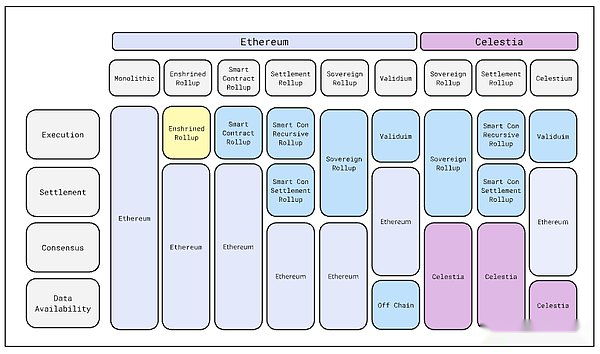 The advantage of modularity is professionalism, whether it is affordable DA (data availability) or under -chain execution.It is similar to Adam Smith that labor division of labor is a source of economic growth. Specialized (labor division) can promote scalability (growth) by improving efficiency.
The advantage of modularity is professionalism, whether it is affordable DA (data availability) or under -chain execution.It is similar to Adam Smith that labor division of labor is a source of economic growth. Specialized (labor division) can promote scalability (growth) by improving efficiency.
On October 2, 2020, Vitalik turned to Rollup as the main expansion solution of Ethereum -Rollup was a natural extension of “modular rise”.The ultimate goal of Ethereum is to become a financial layer with global coordination, and to achieve the expansion of the scale of this goal.However, considering the dilemma of scalability, Ethereum optimizes decentralized characteristics and security at the cost of sacrifice scalability.By packing multiple transactions into a transaction package, and then submitting the transaction package to the main network of Ethereum, Rollup increased the transaction throughput and reduced the transaction cost.This method minimizes the amount of data processed on the chain, thereby achieving faster and cheaper transactions.However, with the increase of the number of Rollup, the complexity of Ethereum’s ecological interaction will also increase accordingly, because additional infrastructure needs to be constructed to connect rollup to the rest of the ecology.
 Celestia’s scalability is enhanced through its unique data usability sampling (DAS) method.This allows the network to expand with the addition of more light nodes, so as to achieve greater blocks without affecting security or decentralization.
Celestia’s scalability is enhanced through its unique data usability sampling (DAS) method.This allows the network to expand with the addition of more light nodes, so as to achieve greater blocks without affecting security or decentralization.
3. Chain abstraction
In order to surpass Web2, web3 UX (user experience) needs to provide an absolute and better experience (considering the conversion cost).This is the place where the chain is abstract.
As a concept, instead of chain abstraction is the method of achieving the ultimate goal, it is better to say that it is closer to the ultimate goal.Therefore, “chain abstraction” is a user experience, and any component/improvement can be considered to be dedicated to “the future of the chain abstraction.”
To become a multi -chain user in today’s encryption world, you need to set up a capital bridge between many chains and shuttle in complex UI (user interface).Risk characteristics.Users need to interact with the various “pipelines” of the encrypted economy. This is a tedious and complicated experience -the equivalent “pipeline” in traditional finance will be traded on the Fedwire (Federal Reserve fund transfer system).Considering the abstraction of chain from the WEB2 UX type, there are two key pain points to solve: the complexity of the web3 UX, and the fragmentation of users and liquidity.
4. Abstract in web2
In the context of computer science, the definition of abstraction is as follows:
Simplify or eliminate technical complexity from the user experience to generate techniques that hide these details and processes.These complexity still exists and plays a role, but it is not visible for users.
In the web2 world, through the hidden technical complexity of various operations and presenting a simplified interface to users, abstract player has played a vital role in creating user -friendly seamless experience.For example, users interact with the website through browsers without understanding what is underlying protocols such as HTTP, TCP/IP or DNS.Users only need to open Outlook, write emails, and send them -they do not know that their emails and SMTP such as sending protocols and IMAP/POP receiving protocols have interacted.Web hosting and cloud services abstract server management, data replication and load balance, providing user -friendly interfaces for easily deploying and managing applications.The authentication and authorization process (including password hash and session management) is hidden behind the simple login interface.Online payment services like PayPal and Stripe abstract security encryption, fraud testing and bank network communication, and support users to conduct effortless transactions.The most important point is that web2 provides an experience that non -Internet native users can also browse. Web2’s concern for abstract has made this technology easy to access.
As the preferred search engine, Google can be considered the ultimate abstraction.By a wide range of guidelines for the Internet, it simplifies the information retrieval process and allows users to enter search requests without having to understand the complex search algorithm or network crawling process.Google’s algorithm indexes billions of web pages and rank them according to correlation, so as to present the most important results to users.This abstraction means that users do not need to understand the technical knowledge about SEO, HTML structure or network hosting, because Google hides these complexity and provides direct and systematic search results.In addition, Google also provides most of the previous services -email (Gmail), Google Docs, Google Drive and so on.Through a unified interface that can be accessible, Google further enhances the user experience by concentrating various functions into a highly condensed ecology.
Let’s further understand this: Web2 consists of many protocols. These protocols operate with each other. In terms of abstract demand, web2 and Web3 are not much different from the “bottom layer”.For ordinary web2 users, these protocols do not need to be understood. This simplified user experience can be used as chain abstract fingers.
5. Formally defined
Chain abstraction- “User experience for manual processes required for multi -chain interaction”
Let’s look at the problem that the chain abstraction is trying to solve:
-
Bridge -users need to connect value to different chains, which not only brings major user experience frictions, but also bring security risks.
-
GAS tokens -users need to obtain and manage different tokens on different chains to pay GAS fees.
-
Fragmentation of accounts and wallet -users need to interact with multiple accounts to access all their balances.This problem is more serious in the non -EVM ecosystem, because individual addresses and wallets need to be needed.
-
Fragmentation of liquidity -As the number of blockchains increases, liquidity is scattered, and it is further isolated on these chains.
6. Fragmentation problem
As mentioned earlier, the roadmap centered on Rollup, which is incentive, and the popularization of the application chain, specific application Rollup and “owning their own stacks”, which has led to the intensification of liquidity and user fragmentation, unity, and unityThe disintegration of smooth user experience.
Generally, supporters of “single architecture” will take Solana and other non -EVM chains (such as SUI and APTOS) as examples to show their simplicity to users.
If the user receives the fund bridge to Solana, they usually only need to interact with a form of USDC and a form of SOL.Because Wormhole and Axlar USDC already exist, Solana has its own problems in USDC’s mutual mutual mutual mutual mutual mutual mutual mutual interdependence, but these problems have been solved or improved to a large extent.Solana’s “ecology” refers to Solana and applications built on it.(At present) There is no L2 yet, and there is no need to obtain more liquidity or different application subsets through bridge connection.
In contrast, when users log in to Ethereum ecology (including Rollup), they will encounter various forms of USDC and various forms of ETH.For example, although ETH and Arbitrum on Optimism are the same assets in all intentions and purposes -both use their respective norm bridge connections from the main network bridge of Ethereum -but they cannot be used.Some applications are only running on Optimism, while other applications only exist on Arbitrum.For all actual purposes, ETH and Arbitrum on Optimism are located on a completely different chain, with different ecology and different use cases.
Even at the wallet level, the two are regarded as different assets.Emerging wallets like Rabby and Rainbow have worked hard to blur and abstract assets at the wallet level.Nevertheless, users will find that the assets they manage are “replaceable” (in fact, almost an irreplaceable way), crossing multiple chains and rollup.
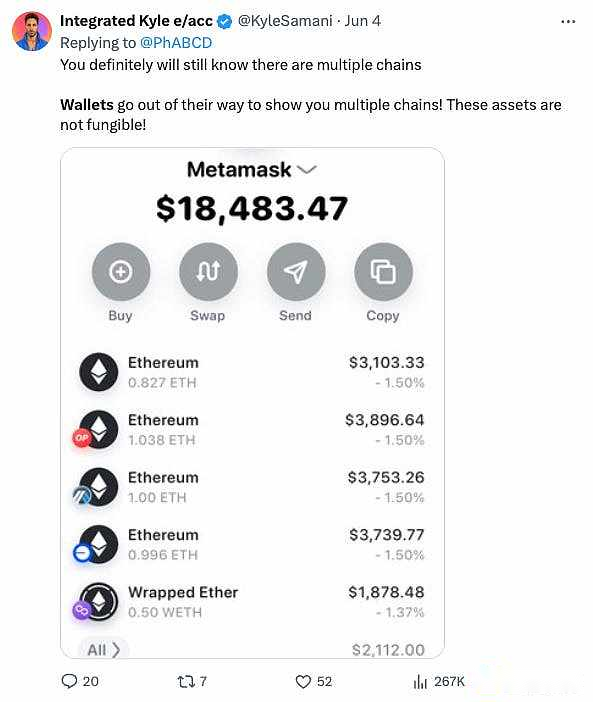
This difference is more obvious at the non -Rollup level.For non-EVM chains (such as Solana, SUI, APTOS), and Ethereum EVM L1 (such as BNB and Avalanche C-Chain), users must also handle non-native assets (AXLUSDC, Axleth, etc.).
Theoretically, if Rollup fulfills their promises, completely stripped the Ethereum users, and becomes their own “single” chain above Ethereum, then there is no need to bridge and seek liquidity.However, this is not the case.The three largest Rollup: Arbitrum, Optimism, and Base, each with different ecology, use cases and users.Optimism has shifted to increase the additional modular level: with the super chain (detailed later).Arbitrum is mainly focused on DEFI (especially perpetual contracts and options DEX). Recently, with the launch of XAI and SANKO, more and more attention has paid attention to L3 (Arbitrum’s own additional modular layer).Base mainly focuses on the SocialFi application.
It can be seen that “GM” L2 has begun to develop their own specific focus and use cases.Users who want to play games must bridge the bridge to receive Arbitrum, and then the bridge to XAI or Sanko.If the same user wants to make a degen reward on FarCaster or buy a key (Key) on Friendtech, they must bridge the Base.If the user wants to use Synthetix, they will have the bridge to receive Optimism.The end result is high fragmentation, and this is not intentional.Generally speaking, each general L2 should be committed to providing a variety of applications to meet every needs of users: providing a single experience in a modular settings.But this is not the case, there are two reasons:
-
Due to the low TPS of Base Rollup, especially in the game, Rollup must use a certain form of modular architecture to execute to other environments (such as L3).
-
Due to different incentive mechanisms and other methods that introduce users and developers into their chain, each general Rollup inadvertently forms different cultures and ecology.
L1 is the same.Some applications and users only exist on Avalanche C-Chain or BNB or SUI and Aptos.
The problem of fragmentation will not only affect the user, but also the execution layer and the agreement itself.Due to fragmented, the revenue of the execution layer and MEV will be devoured by Rollup (under MEV) or other chains.With the intensification of competition between the execution levels, this becomes more important.
For the agreement, the situation is very challenging because they must start on many chains and try to guide liquidity and users on all chains.This is particularly difficult for new products, because their goal is to get as many users as possible.In addition, each underlying chain and each bridge connection of the protocol operation will increase complexity and increase security risks.
In general, the fragmented problems within the encrypted world, especially in Ethereum, is at the highest level of history, which leads to less ideal user experience and traffic.
Solve the problem of fragmentation: chain abstraction
This fragmentation problem has spawned the birth and development of chain abstraction.As mentioned earlier, we use the abstraction of chain as the ultimate goal: encrypted users can get a better experience of actual optimization, without having to deal with many issues related to the management of the bridge, GAS payment, complex UI and multi -chain wallet management.
In order to achieve the ultimate goal of chain abstraction, a large number of attempts have been conducted, from comprehensive solutions (such as Agglayer, Particle Network, and OP Superchain to component solutions (such as intended networks and bridge aggregates).
Usually, it is ironic that one of the key issues of chain abstraction is the fragmentation of the chain abstract solution.Generally, we see that the chain abstraction solution tries to “have” the abstract chain.For example, the Superchain of Polygon’s AggLayer and Optimisms tries to abstract Rollup fragmentation through unified liquidity, message transmission, bridge or other components.However, both need chain to choose their solutions, which is accompanied by the problem of incentive imbalance.Finally, all chains often want to have their own stacks.
In addition, they can’t work well.Although the Rollup on Polygon Agglayer benefits from unified liquidity, and Superchain’s Rollup benefits from unified message transmission and exchanges applications and resources, but if the user wants to interact with the two at the same time, they will still face badness.User experience.
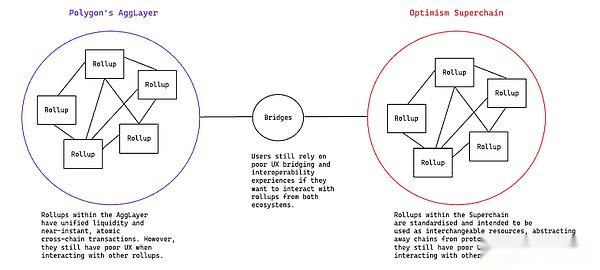 In addition to the fragmented problems of some abstract solutions, especially at the level of component levels, another problem is related to the method of treatment.
In addition to the fragmented problems of some abstract solutions, especially at the level of component levels, another problem is related to the method of treatment.
The reality is that chain abstraction is a multi -faceted problem. It can be solved through many different angles: it includes not only what problems should be solved, and how to solve these problems.
Some powerful efforts have been made on how to deal with chain abstraction. The most prominent of which is the Cake framework proposed by Frontier Research.We strongly recommend that readers read the CAKE framework by themselves, but in general, FRONTIER outlines the chain -drawn key element (CAKE) framework consisting of three infrastructure layers: licensed layer, solver layer, and settlement layer.
The license layer refers to where the user connects the wallet to the protocol and the application and submits the intention. The user signed the message here.The license layer is responsible for identifying the user’s assets and executed transactions.
The solver layer includes Solver and Fulfiller (executor), which provides quotations and execution intentions based on the cost and speed of execution based on the user’s assets and intent.
The settlement layer ensures user transactions.If the transaction is set to a chain different from the original chain, it will receive the asset bridge to the chain and execute it.
Compared with the CAKE framework, we think that a more practical method can help the development of chain abstraction.In simple terms, we divide the chain abstraction solution into two categories: comprehensive solutions and component solutions, each category has further subclasses.
7. Comprehensive design space vs component design space
Considering that the word chain abstraction (CA) is very vague, we will divide the design space into two -integrated CA solutions and component CA solutions.The integrated CA solution is defined as a solution to seek abstract multiple frictions to provide CA with a “full stack” solution.As far as the user experience is concerned, the comprehensive solution is similar to a single blockchain.Component solutions are solutions that try to solve a single problem and make their own contributions to greater solutions.It is worth noting that this report does not study every solution related to chain abstraction.Chain abstraction is a broad concept, more like a motivation and ultimate goal, not a category.The following agreements, networks, infrastructure layers, and EIPs help clarify and represent how some types of solutions help chain abstraction.In the past few months, people have conducted a wide range of research on chain abstraction. There are many discussions on chain abstraction at the recent encryption summits. During the conference, many agreements, infrastructure projects and researchers have used this or researchers.In this way, pay attention to chain abstraction.
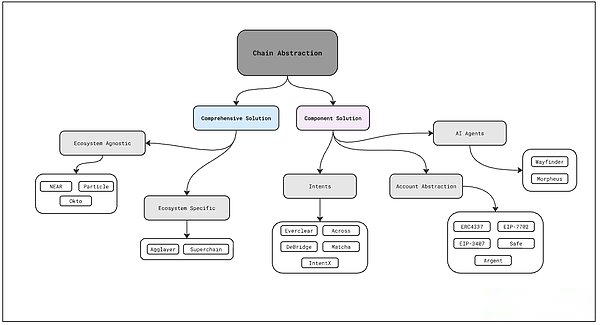
8. Comprehensive solution
There are several large companies in the field of comprehensive solution -Near, Particle, OKTO, Polygon Agglayer and OP Superchain.These five solutions can further subdivide into a solution that has nothing to do with ecology (Near, Particle, OKTO) and solutions specific to ecological solutions.In short, the difference between the two is the scope of the CA solution.
All chains on Polygon Agglayer are connected through a bridge contract, which makes the value transfer between the chain in this ecosystem without friction, but such a user experience is limited to users of the Polygon CDK L2.The design of the OP super chain is similar to that. A unified bridge contract connects all chains in the ecology to make the value transfer between them quite simple.A solution that has nothing to do with ecology provides a solution that is not limited to their respective ecology. Users can transfer value between different chains and trade on different chains.These three solutions that have nothing to do with ecology abstractly implement the role of representative users to transfer assets on other chains -essentially, this is their main products.
 Chain abstraction solutions like Near have been preparing since 2018, and other agreements are relatively new for abstract fields.Considering that most CA solutions are still in the early stages of development and the differences of various methods, it is difficult to choose a leading sheep.In this field, the leading sheep can consider the use of the main products of each protocol, and once again considering that these protocols are still in the early stage of development, it is really too early at this time.
Chain abstraction solutions like Near have been preparing since 2018, and other agreements are relatively new for abstract fields.Considering that most CA solutions are still in the early stages of development and the differences of various methods, it is difficult to choose a leading sheep.In this field, the leading sheep can consider the use of the main products of each protocol, and once again considering that these protocols are still in the early stage of development, it is really too early at this time.
(1) Particle
As the settlement and coordination layer of all users on the chain, PARTICLE’s modular L1 (can be considered as a underlying infrastructure layer, not a general L1) aims to provide a chain abstraction experience for encrypted users.
The main product of Particle is Universal Accounts -allows users to use a single address, account balance, and interactive point on all chains (EVM and non -EVM chains), and abstract GAS and unify liquidity.Based on COSMOS SDK creation, Particle is essentially modularized. Therefore, key functions such as verification and data availability are outsourced to professional participants while retaining sovereignty.In essence, modularity refers to the different aspects of the blockchain operation through the exchanges of independent modules.This allows PARTICLE to maintain its control of its core functions and governance, while also adapting and developing its modules.
Particle depends on the three core modules:
-
General account: These accounts provide a balance of interaction points, user addresses, and the balance of all chains (EVM and non -EVM networks).
-
Universal liquidity: The liquidity of all chains is unified through cross -chain atomic transactions and exchange Optimistic execution.This allows users to interact seamlessly with the new chain, even if they do not hold tokens.
-
General GAS: Allows users to use any tokens for cross -chain transactions.
Universal liquidity
The general liquidity of the PARTICLE network acts as the underlying layer that supports seamless atomic cross -chain interactions, and realizes the unity of the balance in the general account.Through the realization of universal liquidity, users using cross -chain applications have experience similar to interacting with single -chain.
Universal liquidity -a typical example:
-
User A wants to use its own USDT to buy NFT with a price of 1 ETH, and USDT is randomly distributed on chain 1, chain 2 and chain 3.
-
By clicking the “Buy” button, the user package the user involved 5 chains (chain 1, chain 2, chain 3, chain 4, and particle network) and send it to a signature to Particle L1.
-
After executing the above signatures, USDTs on Chain 1, Chain 2 and Chain 3 are converted into intermediate tokens through the corresponding chain DEX (decentralized exchange), such as USDC.
-
Chain 1, chain 2 and chain 3 USDCs are sent to liquidity provider (LP).
-
USDC on LP release chain 4.
-
The USDC on the Chain 4 is exchanged for ETH through the DEX on the Chain 4.
-
ETH on Chain 4 is used to buy NFT.
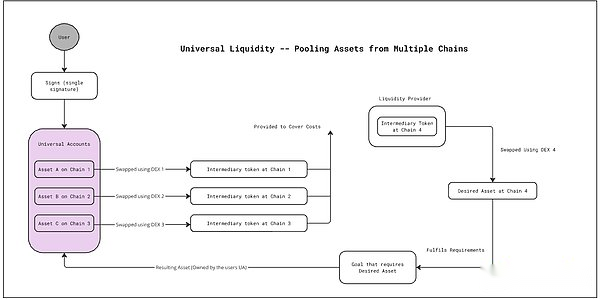 Universal account
Universal account
PARTICLE’s general account plays a core role in PARTICLLL’s chain abstraction products. They provide users with a single address, balance and interaction point of cross -multi -chain ecosystem.The PARTICLE universal account uses universal liquidity to automatically execute cross -chain atomic transactions, and collects funds from the user’s cross -chain balance to meet the conditions for the given operation.General accounts provide users with a unified interface in EVM and non -EVM ecosystems, and provide them with the ability to store and use funds on any blockchain.The core of a general account is the PARTICLE general liquidity technology, which automatically coordinate cross -chain transactions based on each transaction.Particle network acts as the settlement layer of these transactions.
The general account is essentially the EOA (external address) ERC-4337 smart account implementation.Implementing the PARTICLE general SDK protocol will be assigned or parsed to a general account with a given EOA address, and inquiries by using the PARTICLE network’s modular smart wallet, the service of the service.The account is then used as the core interface of interaction with the application, and any other application using the PARTICLE network SDK.
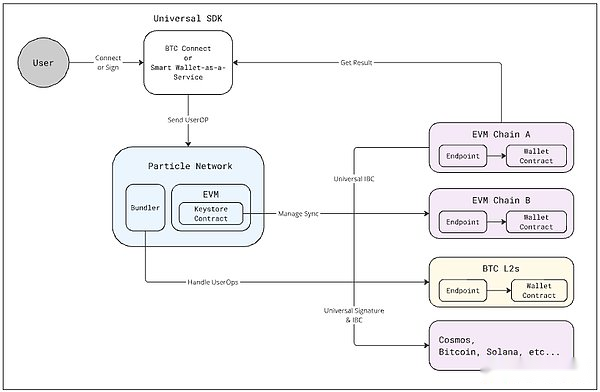
Example of hypothetical end users:
-
Alice discovered a DAPP.The DAPP hosting is on Arbitrum and uses the general SDK of the PARTICLE network to achieve general accounts.
-
Alice started using the DAPP.The assets in her wallet (native to Polygon) are used for basic DAPP interaction.The bridge is automatic and automatically executes during interaction.
-
After playing for a while, Alice made some tokens.She bought a NFT as a birthday gift for her friend Bob with this money.What she doesn’t know is that the NFT hosting is on Optimism.She can seamlessly send the money to the Bob’s general account.The important thing is that in her entire experience, Alice only uses a GAS tokens.
-
BOB decided to mortgage the NFT on the loan on Solana and buy a Meme Bitcoin order with the income.He finished all this through the same account in a few minutes to complete it.
Bitcoin, Particle and account abstraction (AA):
The introduction of inscriptions and order (order) introduced the revival of the Bitcoin L1 event.
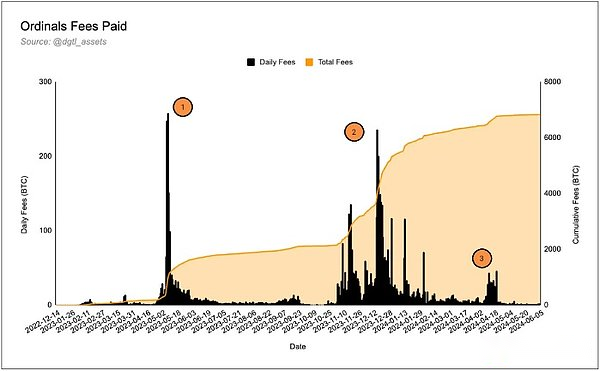 Various Bitcoin L2 has appeared, and the calculation limit is extended to the Bitcoin basic chain. Examples in this area include BTC L2 compatible with EVM, such as Merlin, BEVM, and BSQUARD.This represents the leap in Bitcoin and the entire industry, but their design and supporting infrastructure will still lead to considerable friction at the wallet and UI/UX level when cross -network interaction.
Various Bitcoin L2 has appeared, and the calculation limit is extended to the Bitcoin basic chain. Examples in this area include BTC L2 compatible with EVM, such as Merlin, BEVM, and BSQUARD.This represents the leap in Bitcoin and the entire industry, but their design and supporting infrastructure will still lead to considerable friction at the wallet and UI/UX level when cross -network interaction.
This is the use of PARTICLE and BTC Connect. Their goal is to solve friction and bring account abstraction to Bitcoin.BTC Connect realizes the abstraction of accounts on the Bitcoin network through unified users’ bitcoin accounts and EVM -based smart accounts.This is done by using the SIGNER (signature) of the Bitcoin Wallet as the SIGNER (signature) of the smart account on the Bitcoin L2 or EVM network, so that the user’s existing bitcoin wallet has become the only interactive point.This architecture is designed with EIP-4337 (supports multi-signature wallets, social recovery, and more complex trading logic at the wallet level) and EVM compatibility chain, introducing smart accounts, Paymaster, Bundler, and unique Bitcoin wallet connection mode.
Therefore, all interactions on the smart account and the original Bitcoin wallet can be controlled by the Bitcoin wallet.BTC Connect extend the function of Bitcoin wallet.Using a single Bitcoin wallet, users can send native BTC transactions to interact with preface, and perform logic on compatible EVM Dapps and Bitcoin L2.
This allows BUILDER (builder) in the Bitcoin ecosystem to provide users with no GAS transactions, account programming, and many other abstract functions.
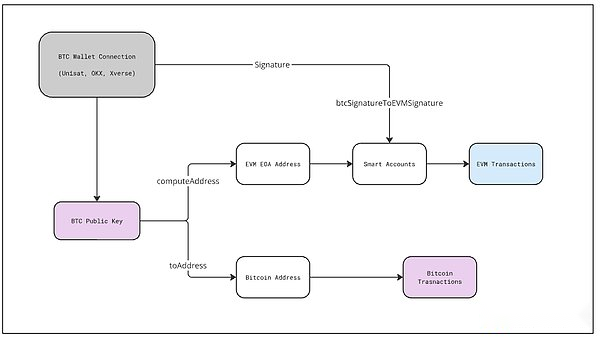
The public key of Bitcoin Wallet is used to perform native BTC transactions and generate EVM EOA.The EOA is used to create a smart account with Bitcoin wallet as the signature, so the Bitcoin wallet signature is compatible with EVM.
(2) Near
Near is developing a comprehensive chain drawing stack, focusing on account aggregation.The ability to trade through a single account and interface on any blockchain is a key component of chain abstraction.This will clean up web3 fragments for the APP users and improve their ability to flow across the network or cross -applied program.
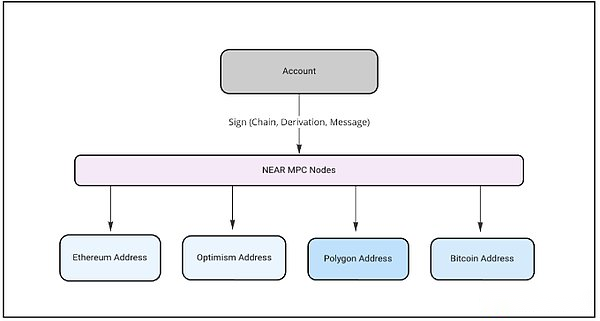
NEAR account aggregation includes 3 core technologies:
-
Near Account -Near is built with abstract use of native accounts, so the Near account is mapped to the name of the account that can be readable, not the public key hash.In addition, the Near account can hold multiple keys with different authority for different functions.FastAuth provides users with a web2 -like guidance process. Users use email registration without managing private keys.The FastAuth account and keys are protected by biometric identification “PASSKEY” security characteristics (thinkd).Users can also recover the account at any time through multi -computing (MPC) recovery services.
-
Chain signature -this allows any Near account to control the address on other chains.Using chain signs, the Near MPC network is a signature of other chain transactions, and it does not need to manage different wallets and private keys.The MPC signature allows multiple independent nodes to use the key Shares to sign the message to sign the message without gathered them anywhere.

-
Interests of Relayer (Revolution) -In in order to pursue a smooth user experience, users should be able to pay on the Near network and then be able to trade value on other chains.With the intention of Relayer, users can specify what they want to do without need to know how to complete it.The task of the intention relay network is to monitor the response from MPC services, deal with signature transactions, submit them to their respective chains, and then complete the final transaction.
(3) OKTO
OKTO is a middleware solution, which aims to simplify the complexity of Web3 for developers and end users.It abstracts the complexity of blockchain interaction, making it easier to build and use decentralized applications.OKTO believes that a end -to -end solution is required to solve the challenges of development experience and user experience at the same time.For this purpose, they launched an orchestration layer that can abstract the complexity of Web3 and solve the development/user experience by solving three aspects of fragmented problems (liquidity, technical standards, and user experience)Essence
Components of OKTO arrangement layer:
-
OKTO APPCHAIN —— a middleware chain, coordinates the transaction without holding user assets or total locking value (TVL).As a Rollup -based application chain, it has the underlying security/scalable blockchain inheritance trust.Key subcutors include BLOC Hub and a set of unified applications to develop APIs.
-
Decentralized wallet network (DWN) -Coloning a unified wallet account supported by MPCs, and allowing user -based commissioned signatures to support EVM and non -EVM chains.
-
Sub -transactions that coordinate asynchronous transaction management across multiple blockchain and handle user operations, including NONCE management, GAS cost estimation and data indexes across multiple blockchain.
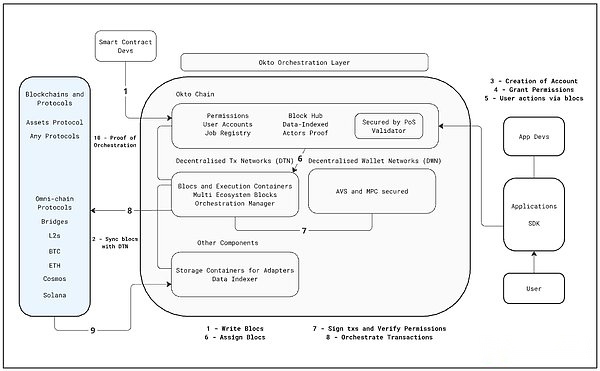
OKTO’s goal is to provide a chain abstract solution through its arrangement, which consists of the application chain, DWN and DTN.This layer abstracts the complexity of standards, chains and protocols, and provides a consistent development experience.It allows developers to use simpler primary and better user experience to build DAPP, focusing on their core products, and the complexity related to the chain is managed by OKTO.
9. Specific ecological solution/aggregate blockchain
The aggregate blockchain can be considered a blockchain expansion solution, which provides a assistant advantage of chain abstraction.It can be said for granted that we will find ourselves to a multi -chain world. At present, no chain can support the large -scale use of the required throughput.In order to expand the blockchain, we need to increase access to liquidity and sharing state -if increased block space will destroy liquidity, then it is not a feasible solution.This is the concept behind the aggregate blockchain.
(1) Polygon Agglayer
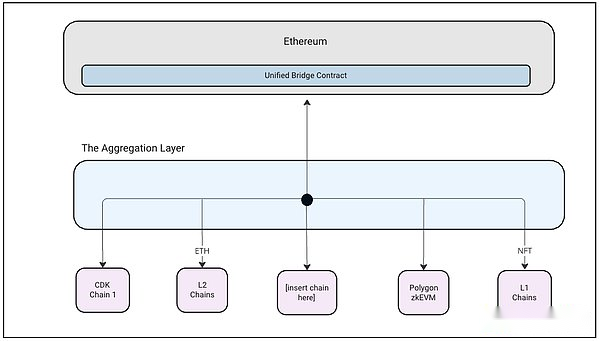 Before studying Polygon Agglayer, we need to quickly browse the Polygon ecology:
Before studying Polygon Agglayer, we need to quickly browse the Polygon ecology:
-
Polygon = a global network of aggregate blockchain
-
Agglayer (unified liquidity) = A protocol that unifies the multi -chain network liquidity by aggregating a proof of the closing chain to ensure the safety of nearly instant cross -chain atomic transactions.
-
Polygon CDK (extension) = a modular open source tool collection allows developers to deploy their own sovereign ZK (zero -knowledge certification) L2, or allow existing L1 and L2 chains to be migrated to Agglayer.
Polygon explains the concept of chain abstraction from different perspectives. Their unified bridge contract provides the benefits of integrated (single) and modular architecture through the use of ZK technology.Agglayer is the interoperable layer of the CDK chain connection, which can achieve seamless and efficient cross -chain communication and unified liquidity.Without sacrificing sovereignty, unified encryption security and composable atomicity are achieved between the polymer chain.Polygon claims that similar to TCP/IP, Agglayer will unify the blockchain pattern into a network consisting of L1 and L2 chains with zero -knowledge security guarantee.
Agglayer’s function is divided into three stages -assuming that chain A is a ZK driver chain running in the Polygon ecology:
-
Pre -confirmation: Chain A submits the header (block head) and light client proof of the new block/trading package A1 to Agglayer.The Header file contains all other blocks and trading packages (BI, CI, etc.) dependent on A1.When a new transaction package that does not contain validity proof is received, it is identified by Agglayer as “pre -confirmed”.
-
Confirmation: Any complete node of the chain A or A generates A1 and submits it to Agglayer.Once proved to be verified by Agglayer, if all the trading packs it depends on are also confirmed, A1 is confirmed.
-
Final Determination: After A1 is confirmed, its proof is collected into a separate proof with a trading package from other Rollup and published it to Ethereum.The aggregation proof is strongly dependent on chain status as the trading package.
Seamless, efficient cross -chain communication and unified liquidity -Practice:
Imagine such an example. Alice on Chain A wants to lock or burn some tokens in block A1 in order to cast assets and transfer these tokens to BOB on the chain B.Chain B needs to wait until these A1s are finally confirmed on Ethereum and provided effective proof before cast assets. This process is very slow.Agglayer temporarily assumes that A1 is valid and will be finalized on Ethereum to solve this problem by allowing A1 to solve this problem.Before submitting to Agglayer, the sorter of the chain B submits the declaration of the chain A state A1 as the block head (B1A1) dependency item of the statement of the statement, and the delay required for the chain B to build B1 from 20 minutes to a few seconds to a few seconds.bell.
Agglayer’s unified bridge is connected to Ethereum to provide a bridge contract for all closing chains.Each chain has a local copy of a unified bridge root, so as to achieve cross -chain transactions without exiting to Ethereum, and there is no security risk of a third -party bridge.Agglayer also contains a Bridgeandcall () solidity library -which allows developers to deploy program logic for executing calls on different chains.Users can transfer assets to different chains, and can also trigger contracts on the target chain.In theory, this provides a user experience similar to a single chain.
So, how does Agglayer support chain abstraction?From the perspective of high -level perspectives, Agglayer will achieve nearly instant atomic transactions and unified liquidity within the entire ecological range, create better capital efficiency, and provide improved user experience.L1 and L2 connected to Agglayer can use unified liquidity. Developers can expose wider users, and users can interact with Web2 user experience.
(2) Optimism Superchain
OP Super Chain is a chain network with shared bridge connection, decentralized governance, upgrade, and communication layer. All of them are based on OP Stack.The launch of the super chain combines the OP main network and other chains into a unified OP chain network (many chains form a super chain).Unlike the multi -chain design, a part of the chain that constitutes the super chain is standardized and intends to be used as a replaceable resource.Therefore, an application that targets the entire super chain -abstract app can run the bottom chain on it.
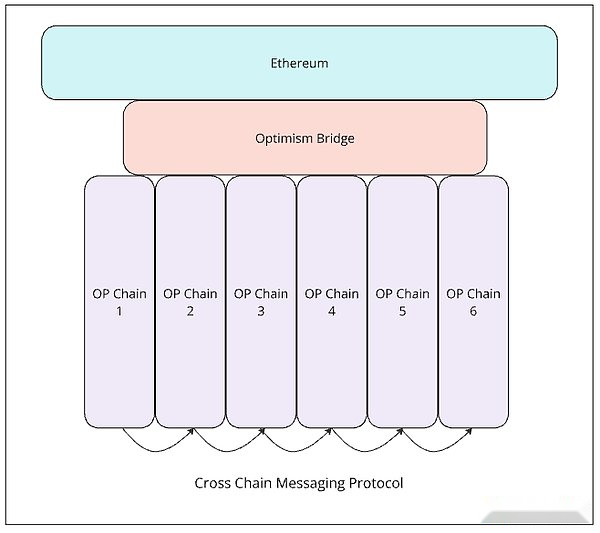
OP stack:
-
Data availability (DA) layer specifies the original input of the OP Stack -based chain mainly comes from Ethereum data availability.
-
How to collect and forward user transactions in the sorting layer is usually managed by a single sorter.
-
The derivative layer processs the original data as the input of the execution layer, and mainly uses RollUP.
-
Define the system state structure and trading function of the system.EVM is the central module.
-
The settlement layer allows the external blockchain to view the effective state of the OP Stack chain by proved errors.
10. Component solution
(1) INTENT
Intent is an order that specifies the results of the expectations, not a specific execution path.Users do not need to explain every step of the transaction in detail, but simply state the goals they want to achieve.The external agent called “solver” or “Filler” then competes to find the most effective way to achieve this. It is usually charged.They can be regarded as similar to price limit orders, but they can be applied to various situations (not just transactions), such as bridge connection.
Generally speaking, the intention protocol follows a similar structure:
-
The intention is submitted by the user.Each intention has specifications related to user goals: expected size, target chain, target assets, request prices, expected Solver (for certain intention networks), etc.
-
Solver and Filler use submissions and event monitors to monitor intentions in different intention networks.
-
Solver/Filler can choose to complete the user’s intention.
The above structures are different in different protocols and use cases, especially what assets are used in Solver/Filler, whether they are locked, and where they come from.
Usually, the intention protocol is divided into two categories:
-
Intent -based trading protocol
-
Bypass -based bridge protocol
For all intentions and purposes, they actually have the same functions, allowing users to submit intention and may be executed on different chains or via different chains.
Bypass -based bridge protocol
It has always been expensive, complicated and unsafe to move assets directly between chains.Generally speaking, traditional bridges can be based on mint and lock, mint and lock, or LP mechanism, which may cause problems such as unlimited coins or locking mechanisms.
In contrast, bridges based on intent depends on users to express their intentions and have tokens on separate chains.Solver can complete this request for users on the target chain and use their own funds.Then Solver was rewarded on the original chain.
Bridge -based bridges avoid the needs of coin or lock to tokens, thereby reducing some problems that may be caused.However, it also has its own shortcomings, and more specifically, Filler/Solver may face problems caused by transaction failures and chain rebirth or rollback.
Similar to the traditional bridge, the intention -based bridge must also consider the constraints of liquidity.Solver/Filler needs to maintain liquidity on multiple chains to execute and complete transactions, and at the same time, it is necessary to re -balance these funds on a regular basis.In addition, Filler/Solver is facing capital costs and GAS costs (especially in the target chain).
The benefits of bridges based on intent are obvious:
-
They abstract the back end from the end user.From a user perspective, the intention -based bridge occurs behind the scenes, and users only need to consider paying the agreement and Solver.
-
Compared with traditional bridges, they are usually faster and easier, because the computing resources used are less and the waiting time required is shorter.
So far, the biggest intention -based bridge protocol is Across.Since November 2021, the agreement has passed over a transaction volume of over 10 billion US dollars on each chain.
Across
Across realizes cross -chain asset transfer by systematic system.The user stores the assets on a chain and specifies their target chain.The independent Relayer completed these requests by sending the capital to users on the target chain.The protocol verifies these funds and compensates Relayer.
The ACROSS protocol depends on several key mechanisms to achieve cross -chain asset transfer.The first is the Relayer mechanism.Relayer observes when users deposit funds into the original chain, and then send the request funds to users on the designated target chain.They can use their own funds to execute the request, so they may face liquidity restrictions.However, ACROSS also has a liquidity pool system as a backup solution to solve the intent.After completing the intent, data workers and Optimistic Oracle system must verify that the intention must be completed so that Relayer can get compensation.
Data workers are participants on the whitening list. They reimburse or provide fund compensation for Relayer, re -balance the liquidity pool between the chain, and occasionally perform slow execution.To.They also monitored the intention of Across to execute and proposed trading packages to Optimistic Oracle.Optimistic Oracle can verify the transaction package proposed by data workers (after an hour of dispute window).
The ACROSS V3 focuses on the construction of applications outside the bridge and focuses on more complex cross -chain interactions.The Across+allows protocols to combine the ACROSS bridge with infrastructure with other transactions and include them in one transaction.For example, the NFT market allows users to combine bridges, coins or bridges and purchase interactions into single transactions.This greatly reduces the number of clicks of users, and potentially saves GAS costs, alleviating other user experience problems, such as no assets on the target chain.In addition to Across+, the protocol also launched the Across Settlement to execute the settlement of cross -chain transactions by allowing cross -chain settings to achieve cross -chain settings at the protocol level.Through ACross+and Across Settlement, Across aims to shift from the intention to the more complicated cross -chain interaction from the intention of the intent, and try to become a more modular component of cross -chain transactions, not just the bridge.
Across is particularly important in terms of intentional architecture and protocol because they have been committed to standardization of cross -chain intentions.The team UMA behind the Acrossistic Optimistic Oracle, together with UNISWAP, launched an ERC-7683 earlier this year to establish a standard API interface for cross-chain intentions.ERC-7683 focuses on creating a standardized API interface for cross-chain intent, aiming to enhance the interoperability between different cross-chain intent systems in the following ways:
-
Define a standard CrossChainOrder structure to represent cross -chain orders.
-
Specify the ISettlementContract interface for settlement contracts.
debridge
Similar to ACross, Debridge uses Solver and intentional architecture to realize cross -chain asset transfer and smart contract interoperability.It consists of two layers of structure: protocol layer and infrastructure layer.
The protocol layer is located on the chain, consisting of a set of smart contracts that support the support chain.It processes the locking and unlocking of the token -related currency on the multi -chain exchange, sends the transaction from the source chain to the target chain, and verifies Validator (verified as) to ensure the legitimacy and authenticity of the transaction.As part of the infrastructure layer, the verifications exist under the chain.The infrastructure layer consists of the verifications of the Debridge node and the complete node of the support chain. The former handles and signs cross -chain transactions, and the latter allows verifications to monitor and comprehensively verify the transaction.
Debridge liquidity network is based on these two layers of architecture.It uses households to create limited orders for cross -chain transactions (similar to intention).Similar to ACROSS working methods, DLN allows users to submit intentions, including target chains, tokens, size, and receiver addresses.Solver under the chain can get intention on the target chain to realize them.In order to complete the order, Solver needs to provide detailed information about the intention to the smart contract. Smart contracts need to verify whether the order to be executed is matched with the submitted order.If the order is verified, the contract will extract the necessary quantity of tokens from the solver address to realize the intention and send it to the receiver address.
Intent -based trading protocol
Based on intentional transactions, similar to the bridge, relying on professional solver, and city merchants to find the best execution path.One of the key benefits to users is that it not only allows not only to meet user needs on a separate target chain (similar to the operation method of bridge), but also allows from separate chains to the original chain to meet user needs.This greatly increases liquidity, because it can use households to obtain shared liquidity and execution across multiple blockchains, and allow them to potentially access to liquidity under the chain.
In addition to benefiting from sharing liquidity, intended transactions also allow users to have potentially complicated and previous multi -transaction programmatic orders and conditional execution to a single transaction.For example, for assets that may not even exist on the original chain, users can achieve conditions based on time, quantity or price through a single transaction.In addition to these relatively simple order types, the intention -based transaction can even allow users to execute transactions based on the price trend of other transactions, allow users to execute a series of transactions in specific orders, and even allow online data to trigger transactions.
Finally, the intentional transactions (to a certain extent) make a GAS transaction possible.Users may still need to approve the trading of tokens, but protocols such as Matcha (0x) allow users to sign without GAS transactions that only submit intentions.This makes users not worry about GAS fees.In addition, users must usually pay GAS fees for failed transactions, and designs based on intent can alleviate this situation.
In addition to simplifying user experience and alleviating some user experience related to transactions, transactions based on intent can also improve capital efficiency.Solver, responsible for completing the transaction order, only needs to invest funds when completing the order.This on -demand capital commitment enables Solver to manage its resources more effectively and participate in a broader market without increasing capital demand.Therefore, competition between solver may increase, which may bring better prices and liquidity to traders in various markets.
Everclear
Everclear is a intention -based solution that solves restrictions on re -balance between chains and settlement liquidity.They proposed a new primitive, namely Clearing Layer, allowing market participants to obtain net capital flow between chains before the final chain and bridge were settled.Everclear’s liquidation layer is constructed to Arbitrum Orbit Rollup (through Gelato RaaS) and use Hyperlane with characteristic layers to connect to other chains.
In short, the “re -balance problem” can be understood as: in the process of execution, Solver’s funds transferred from the chain that they needed to do not need their chain.In order to effectively reconnect, Solver must integrate with the bridge, polymer, CEX, OTC counter, and any other available liquidity source of each support chain and assets.The process of balance is expensive, and these costs will eventually be passed on to users.
This is the place of Everclear’s martial arts. They provide a sharing system for all market participants to coordinate capital flow and support cross -chain settlement.In all cross -chain flows, it is surprising that 80%can be deducted -this provides a huge opportunity for reducing the cost of end user.Perhaps the solution to liquidity fragmentation is not to establish another bridge or liquidity layer, but to help existing participants better coordinate.
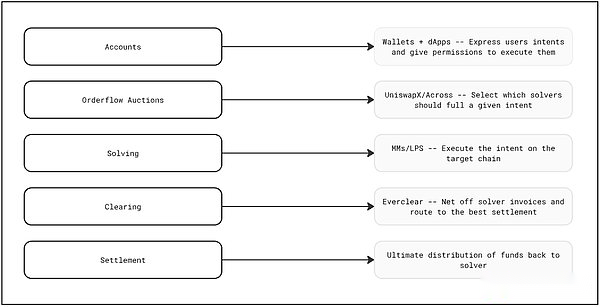
In this system, the deposit will generate Invoice on Everlear Rollup. The Invoice represents the obligation to settle the system to the user (funding supported by locking in the gateway).A typical example is as follows:
Suppose that Alice and Bob are the Solver’s Solver’s Solver’s Solver.Alice is more inclined to Arbitrum, while Bob prefers Optimism.
-
Alice executes an Optimism-Rabitrum transaction.BOB executed a 20 ETH Arbitrum-OPTIMISM transaction.
-
Suppose funds from two original transactions (10 eth and 20 eth) are stored in Everclear on Optimism and Arbitrum, respectively.
-
Everclear’s 50%of the BOB’s 20 ETH deposits immediately settled Alice’s 10 ETH settlement to Arbitrum with nearly zero costs.
-
Everclear wants to settle the BOB transaction, but only 10 ETH can be used for settlement on Optimism.The system auctioned his Invoice and discounted its price from $ 1 to $ 0.99.
-
Charlie noticed this and stored 9.99 ETH on Optimism.Everclear settled the BOB transaction with 19.99 ETH on Optimism.Charlie now holds an Invoice of 10 ETH and earns 0.01 ETH profits.
Alice and BOB finally returned to their respective chains to prepare more transactions.It is important that this happened in the condition of zero operation and near zero cost.
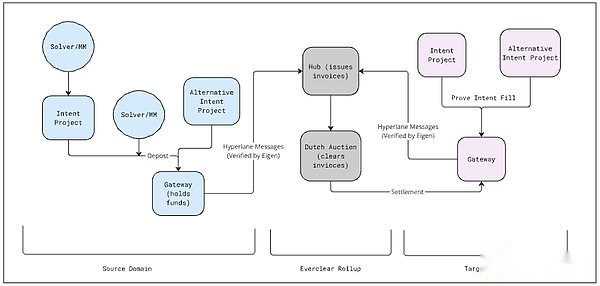 Intentx
Intentx
IntentX is a intention -based permanent contract trading platform. Traders express their expectations (intent), and then realize the city merchants called solver.
The platform uses Symmio as the settlement layer, using the Symmio-Core contract to settle transactions, and promote direct bilateral trade protocols on the chain.Symmio is a trading back end of the point -based derivatives on the chain of intent. It realizes off -site derivatives transactions through symmetrical contracts (a group of bilateral agreement without trust and no license).
These symmetrical contracts continue to monitor the solvency of all participants and mediate any parameter differences.This ensures that the settlement of derivatives between all parties does not require trust and permission.In essence, Symmio is paired with the respondent to lock them in an isolated symmetrical transaction.This looks similar to the intent of the intent on Across or Debridge:
-
The user submits intention, specifies the details of the position and the whitelist Solver.
-
The whitelist Solver uses a subgraph or an event listener to monitor the intent.
-
Solver, the first locking intention, can turn on the position, if it meets their strategy.Solver can surge in the secondary market, or you can choose a disappearance.
-
The incoming position includes intent to ID, transaction amount, average price and Oracle signature.
-
Oracle signatures ensure the solvency of traders and Solver, and prevent the positions that lead to liquidation.
One of the main benefits provided by IntentX/Symmio is that it can get liquidity from other chains and even CEX.Because Solver can obtain liquidity from multiple sources and use the cross -chain liquidity pool, users can get more preferential prices and can complete large orders at the minimum price effect.
Under normal circumstances, if there is no transaction based on intent, to obtain liquidity from other chains, users will have to bridge, thereby increasing the complexity of the user end.And this complexity and risk were passed to Solver. They may have to hedge their own positions and get a cost of TAKER (receiver) as a return on their intention.
(2) Account abstract
Account abstract allows users to store their assets in smart contract -based wallets, rather than stored in EOA (external accounts).This greatly enhances programming and functionality.
EOA and Smart Contract Account
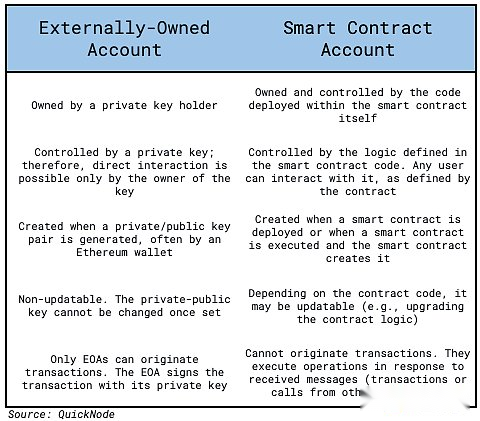
EOA and smart contract accounts are two main accounts in the blockchain, and each account has different characteristics and specifications.The EOA account is controlled by the private key and provides direct user control, while the smart contract account is managed by smart contracts on the chain to provide programmable.
EOA was created under the chain by generating a public private key pair (a typical wallet setting process), which will not cause any costs.In contrast, the smart contract account was created on the chain through transactions, which requires a GAS fee.
Although EOA provides basic and indispensable functions for blockchain interconnect, such as sending transactions, interaction with smart contracts, and managing native assets, smart contract accounts can perform more complicated operations according to their programming logic, so as to allow complex automation to automate automationTypes of transaction and interaction on the chain.This is because the smart contract account contains EVM code and storage, so that they can perform complex operations and maintain the state on the blockchain.
The GAS cost management between these account types is also different.EOA requires native token to pay GAS fees, which requires users to maintain the balance of native currency for transactions.Smart contract accounts may use other toll mechanisms to provide greater flexibility in the processing method of transaction costs.The payment system introduced by ERC-4337 and EIP-7702 is an example in this regard, which supports GAS payment subsidies.
The account abstraction seems to have only a little bit of relationship with the chain drawing, because it does not directly abstract cross -chain interaction.However, it has introduced several key improvements for user experience and supports chain abstraction.
It allows users to interact with protocols and chains without paying GAS fees or managing their private keys, thereby simplifying the guidance process of the new chain and application chain.Agreement and chain can pay users’ GAS fees, Paymaster allows cross -chain payment GAS fees to allow the use of tokens on different chains to pay the cost of the target chain.GAS abstraction allows users to use a token payment transaction fee on different chains, which are completed by the Relayer paid by GAS.
In addition, multiple transactions can be merged into a single transaction through transaction batch processing, thereby reducing the overall GAS cost.Yuan transaction allows users to sign the message under the chain and allow third parties to submit transactions. From the perspective of users, this may achieve no GAS transactions.Wallets can be programmed automatically executed for certain transactions based on predefined conditions, even on different chains.A smart contract that can operate can interact with contracts on different chains to achieve simplified cross -chain atomic transactions.
A common problem to implement account abstraction in Ethereum and EVM is that considering the large amount of assets on it, the foundation layer is very important.It is very difficult to change the protocol layer and may be extremely expensive, and this price is usually avoided.This is one of the main reasons for account abstraction that has not been fully prevalent on EVM. Only a smaller chain can be implemented in a more flexible way (such as Polygon Pos has realized some account abstraction principles).
ERC-4337
ERC-4337 is jointly written by Vitalik Buterin, YOAV Weiss, Kristof Gazso, Der Tirosh, Shahaf Nacson and Tjaden Hess.
It introduces account abstraction and avoids changes in the Ethereum protocol level to reduce the possibility of introducing vulnerability at the consensus level.The ERC-4337 introduces an account abstraction using an ALT memory pool.
ERC-4337 introduced several new components for account abstraction.Useroperations allows users to pack the transactions together instead of manually executing a series of transactions one by one.The simplest example is token approval and token swap. This usually requires two separate transactions to complete, but they can be packaged into a single transaction.Bundler (usually Validator or Searcher search) receives submitted UserOperations and packs them together with other transactions.The submission of Useroperations can be processed through a contract account, and the contract account can start transactions based on a set of instructions or goals.
Finally, ERC-4337 introduces the Paymasters smart contract to achieve flexible GAS policy, such as allowing DAPP to sponsor its users (theoretically supports free transactions), or accept ERC20 (such as USDC) instead of blockchain primary currency (ETH) Pay GAS fee.
Paymasters can pay user operating fees and reimburse the Bunder (sender) to perform these operations.
This process includes a few steps:
* Verify the user operation of the sender’s wallet.
* If the PayMaster address is provided, the PayMaster operation is verified.
* Give up all the user operations that have failed.
* Execute the user operation of the sender’s wallet.
* Track the Gas used for execution.
* Transfer ETH to Bundler for the GAS used.
* If it involves Paymaster, the ETH in the PayMaster contract is used to pay the GAS fee.
* If you do not use Paymaster, send a wallet to reimburse ETH.
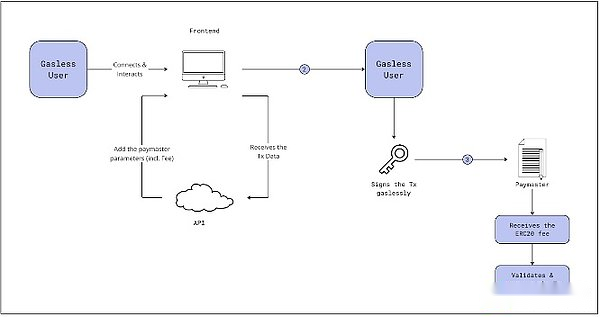
Paymasters eliminates the user experience friction, opened up a new model for users, allows users to pay network fees with non -GAS tokens, and even require third -party payment for these fees.
EIP-7702
EIP-7702 introduces a new type of transaction that allows EOA to temporarily act as a smart contract account.
It is implemented by adding the “Contract_code” field to achieve this. This field allows EOA to use smart contract code and functions in a single transaction to enable GAS sponsorship and batch transactions without permanent migration to smart contracts.
Based on the EIP-3074 concept, EIP-7702 adopts a more conservative method to make the upgrade more short and avoid introducing new operating codes.This proposal has introduced some key functions, such as batch processing (allowing the same user to perform multiple operations in one atomic transaction), sponsorship (allowing one account to represent another account for one transaction payment fee) and privilege downgrade (allow users to use specific uses of specific ones to use specific ones, Limited permissions signs for sub -keys).
It is designed to be compatible and consistent with ERC-4337, allowing existing wallets and infrastructure to use the temporary upgrade mechanism.The proposal has modified the Ethereum agreement to a minimum degree, focusing on the core function of the upgrade of temporary smart contract accounts.In practice, EOA obtains a temporary account code of a transaction. The code is executed when the transaction is sent, and the operation is performed like a smart contract.After the transaction is completed, the account code is abandoned and EOA is restored to its original state.It is expected to be included in the upcoming Ethereum network, that is, the Prager/Electra (PECTRA) upgrade.
Similar to ERC-4337, EIP-7702 allows third parties to pay transaction fees on behalf of users.
Using Paymaster under EIP-7702, users can interact with the Ethereum-based protocol without holding any ETH.Instead, the Paymaster contract will pay GAS fees.
Compared with ERC-4337, the GAS sponsorship mechanism in EIP-7702 is more flexible.It supports various sponsorship modes:
-
Free sponsorship: Applications may pay all GAS fees for their users to encourage users to adopt.
-
Alternative tokens: users can use ERC-20s to pay GAS fees.Paymaster will accept these tokens and pay the actual GAS fee for ETH.
-
Subscription mode: This service may use GAS sponsorship as part of the subscription service package.
-
Condition sponsorship: Paymaster can set the conditions for paying GAS fees based on the trading type, user behavior or other factors.
(3) AI smart body
AI intelligence is an entity on the chain, which can take action after receiving the commands, prompts, or intentions of receiving external participants (that is, users).
They are general artificial intelligence systems to interact with smart contracts on the chain.They can be controlled by users or autonomous.They can independently perform complex multi -step tasks, interact with smart contracts and protocols, provide users with personalized help and suggestions, and generate blockchain transactions according to the user input and execute blockchain transactions.They aim to easily control the encrypted environment, including understanding the interaction and mechanism on the chain, wallet, protocol mechanism, DAO and smart contracts.
The key components of the AI intelligence on the chain can be divided into the following three basic contents:
-
User encryption wallet: This is the basic element of security key management and transaction execution.Encrypted wallets enable users to sign and authorize transactions recommended by AI Smart to ensure safe and verified interaction with blockchain -based applications.
-
Professional encrypted language model: Smart’s intelligent core is a large language model (LLM) specially trained on a wide range of encrypted datasets.This includes comprehensive information about blockchain, wallet, decentralized application, DAO and smart contracts.Specialized training enables intelligence to effectively understand and control the complex encrypted environment.More importantly, after fine -tuning the LLM, the most suitable smart contract can be evaluated and recommended by the most suitable smart contracts to users according to the standard standards, focusing on security.
-
Long -term memory system: This component involves user data and information of related related applications storage local or decentralized clouds.It provides a wider background for AI Smart’s behavior and supports more personalized and accurate help based on historical interaction and user preference.
AI Smart provides several key improvements, including enhancing users’ privacy and data control, improving the incentive consistency between users and agents, and the ability of autonomous transfer value.
But maybe the most important thing is that they may greatly simplify and improve the experience of encrypted users, especially in the background of cross -chain interaction.There is no need to manually operate between different chains and tokens. Users can simply tell their AI intelligence: “Exchange ETH worth $ 100 to USDC and send it to Alice”, and then the smart body will process itTechnical details to ensure the most liquid and cheapest path.In addition to simple interaction, they can also complete more complicated operations, such as income farming or cross -chain LP re -balance, and all of this does not require users to perform various click operations, because users can provide natural language commands for smart parties.
Unfortunately, AI Smart and its potential chain applications have not been really feasible.The recent AI Smart Protocol does not have effectiveness, nor does it give full play to its potential.We focus on the two agreements we think may be related, but they are still in the early stages.One of the main problems (especially on the chain) of AI intelligence is potentially improper behavior, whether it is malicious or unexpected.Since users allow these smartmen to use their funds, they can understand that they may have doubts about whether they fully trust these smart parties, especially because the AI model often has hallucinations or not followed prompts and instructions.Some preventive measures can be taken to prevent this situation, such as setting restrictions or regular injection prompts to ensure correct behaviors -but these are more expedient.
However, AI intelligence represents the huge potential improvement of cross -chain interaction, and it may completely eliminate the needs of the user’s chain interaction and allow them to use natural language commands to give prompts.
Wayfinder
Wayfinder is an AI intelligent body framework and toolkit that is not related to the chain, which is only designed to run on the Solana blockchain.Its main function is to provide AI intelligence with interfaces that interact with blockchain technology and execute transactions.To achieve this, Wayfinder has deployed verification intelligence to evaluate and propose new interaction and execution paths for AI intelligence.These paths define the processes and steps that AI intelligence executes specific exchanges.Although AI intelligence can use these paths to execute transactions, they operate under predefined constraints.They can only perform authorized operations, such as tokens, and cannot use funds without the interaction of the owner.
Morpheus
Morpheus is a protocol focusing on the development of AI intelligence.The project aims to develop a general -purpose personal AI point -to -point network to act as a smart party that can execute smart contracts for individuals.
Morpheus network involves key interests related to the Quartet: developing smart contracts, linked components, and smart coders; put STETH into capital providers in the network fund pool;; And the front end of creating the network and its intelligent body interaction and dedicated to expanding the ecology.In order to coordinate the incentive measures to obtain reasoning, the project uses YellowStone computing model. The model is running under a simplified structure and aims to manage resources in the ecology.
11. Conclusion
Due to the efforts of goodwill (continuous innovation and new improvement at the agreement level) and incentive misalignment (the valuation premium of infrastructure), the surge in Rollup, new chains and application chains in the encryption field leads to serious liquidity and fragmentation of users.Problems and decline in user experience.
This fragmentation has led to a complex and frustrating user experience. Users have to shuttle in multiple chain bridges and manage different GAS tokens.For developers, this means that items must be released on multiple chains and trying to guide liquidity and users on all chains.
The potential solution of chain abstraction is born as the potential solution of these problems.It aims to provide such a user experience to allow users to avoid the manual operation process required to interact with multiple chain.This includes the complexity of abstract bridge, GAS tokens, accounts and wallet fragmentation, liquidity fragmentation and key management.Its goal is to create an experience similar to traditional Internet applications. Users can interact with the blockchain without experiencing steep and difficult learning curves.
Various chain abstraction methods are under development, from comprehensive solutions to component -level solutions.Comprehensive solutions such as Near, Particle and OKTO are designed to provide end -to -end abstraction across multiple chains.Specific ecological solutions, such as Polygon’s Agglayer and Optimism’s Superchain, focus on unified liquidity and improve interoperability in their respective ecology.Component solutions, such as intentional agreements and account abstraction mechanisms, solve specific challenges of chain abstraction.
Based on the intention, whether it is used for transactions or bridges, it is expected to simplify cross -chain interactions and improve capital efficiency.They allow users to express their desired results, not specific execution paths, and Solver competes with each other to effectively execute these intentions.This method may unify cross -chain liquidity and simplify complex cross -chain operations.
Account abstract, especially account abstraction implemented by proposals such as ERC-4337 and EIP-7702, provides improvement in user experience by supporting a more flexible GAS payment mechanism and enabling intelligent contract functions for standard accounts.These innovations can greatly reduce the entry threshold of new users and simplify interaction across multiple chains.
The potential of AI intelligence in chain abstraction is particularly worthy of attention.Although it is still in the early stage of development, AI intelligence can completely change the interaction between users and blockchain technology by enabling natural language commands for complex cross -chain operations.This can greatly simplify the user experience and enable blockchain technology to be used by a wider audience.
Chain abstraction is critical to the development of encrypted technology, especially considering that Ethereum has adopted Rollup as its extension plan, and the narrative of modularized concepts and application chain is also growing.By solving fragmented problems and complexity problems, chain abstraction can create a more uniform and user -friendly chain experience.However, it is more important to pay attention to the chain abstraction itself is also facing challenges.Ironically, the fragments of chain abstraction solutions are reflecting the problems they try to solve.Many proposed solutions are still in the early stages of development, facing major technology and obstacles.
It is worth noting that in the past few months, there are a lot of research on chain abstraction. There are many discussions on chain abstraction at various recent encryption summits. During this time, many agreements, infrastructure projects and researchPersonnel pays attention to the abstraction of the chain in this or one way.In view of this, the problem of user experience and fragmentation is likely to be improved in the next few years.








